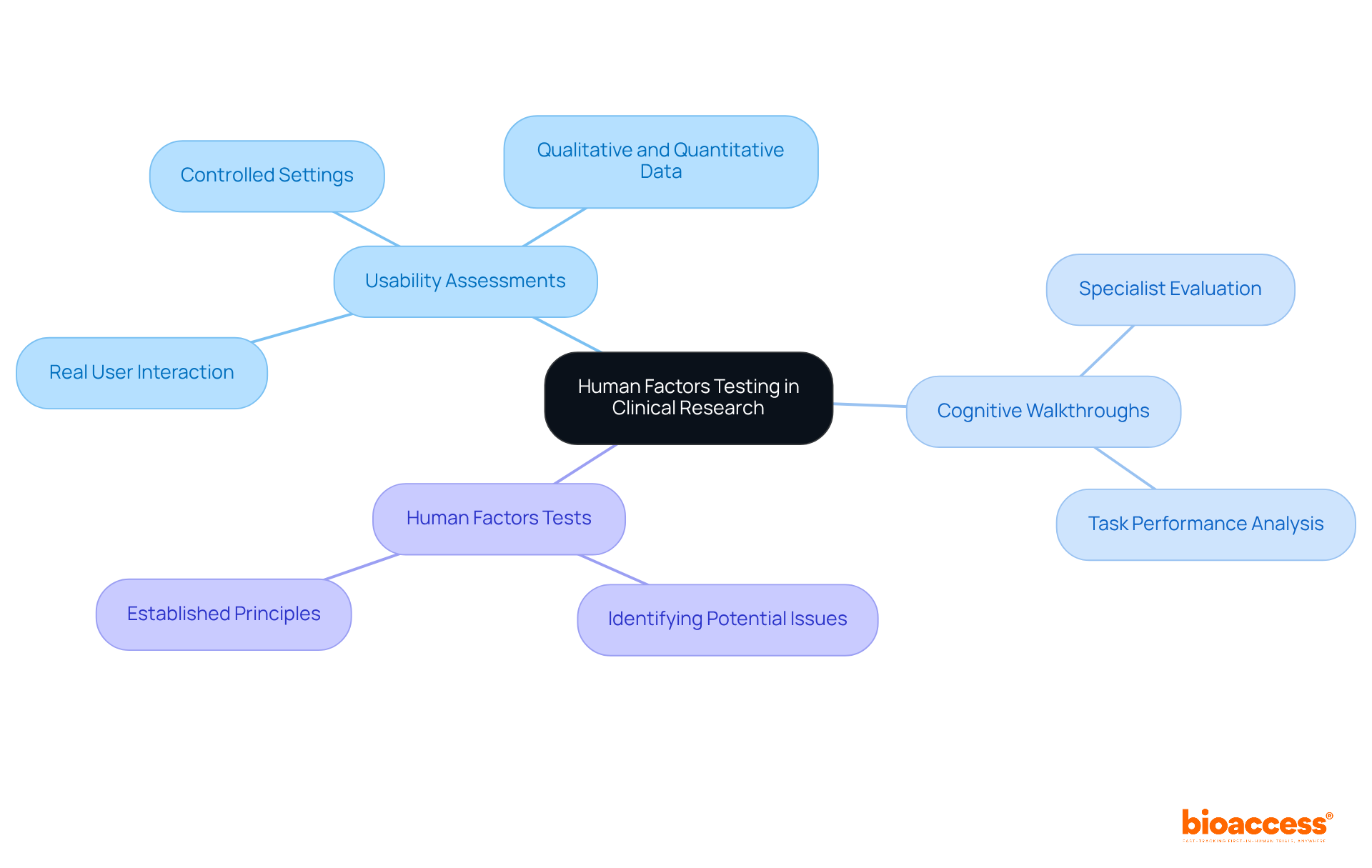


Human factors testing is crucial in evaluating user interactions with medical devices, ensuring their design enhances both safety and effectiveness. This testing not only identifies potential usability issues but also aids in meeting regulatory standards, which is vital for improving patient outcomes and satisfaction. Methodologies such as usability assessments and cognitive walkthroughs play a significant role in this process. By focusing on these aspects, we can better understand the Medtech landscape and the challenges it faces. Collaboration in this field is essential, as it leads to innovative solutions that ultimately benefit patients.
Human factors testing stands as a critical linchpin in the design and evaluation of medical devices, ensuring that user interactions are both intuitive and safe. This testing delves into the principles of usability, enhancing patient outcomes while aligning with stringent regulatory standards.
As the landscape of healthcare technology evolves, organizations face a pressing challenge: how can they effectively integrate human factors testing into their development processes? This integration is essential not only to mitigate risks but also to foster trust among users.
The human factors test is crucial for assessing how individuals interact with medical devices, software, or systems, ensuring that these products are designed with the end user in mind. This assessment is a human factors test that identifies potential usability issues that could compromise safety and effectiveness. By examining user behavior, preferences, and constraints, ergonomic assessment enhances the design and functionality of medical technologies, ultimately improving patient outcomes and client satisfaction. Various methodologies, including usability assessments, cognitive walkthroughs, heuristic evaluations, and the human factors test, are employed to evaluate how well a product meets the needs of its intended users.
The FDA defines the human factors test as the application of knowledge about user behavior to the design of medical devices, underscoring its vital role in ensuring safety and effectiveness. Additionally, adherence to the IEC 62366 standard is essential for compliance with regulatory frameworks related to the human factors test in user experience evaluation.
Statistics reveal that devices developed with robust usability assessment protocols, particularly through a human factors test, experience significantly fewer operational errors, leading to enhanced safety and compliance with regulatory standards. For instance, case studies like Medtronic's user interface redesign illustrate successful strategies in practice, showcasing how impactful usability evaluations can elevate user engagement and satisfaction.
The primary objective of integrating Human Aspects & Usability Evaluation is to minimize use-related dangers and risks, which is assessed through a human factors test. This reinforces the notion that effective user assessment, which includes a human factors test, is not merely a regulatory requirement but a commitment to delivering safe and effective medical solutions. Documenting key elements at the outset of the human factors test process is vital for ensuring comprehensive evaluations and successful outcomes.

Human factors test is vital in clinical research, significantly influencing the safety and effectiveness of medical devices and treatments. Regulatory agencies, particularly the FDA, stress the necessity of comprehensive evaluations of individuals' interactions to mitigate risks associated with errors. The FDA's recent draft guidance classifies medical devices into three risk levels based on use-related hazards and critical tasks, with Category 1 indicating the least risk and Category 3 the highest. This risk-based approach not only clarifies documentation requirements but also underscores the importance of usability in device design.
Identifying usability issues early in the development process allows companies to implement design modifications that minimize the likelihood of serious adverse events, thereby enhancing user experience. This proactive strategy ensures compliance with evolving regulatory standards and fosters trust among stakeholders, including patients, healthcare providers, and investors. In today's competitive landscape, demonstrating a commitment to patient safety and product reliability is essential, as efficient usability evaluations can be a crucial factor in successful regulatory submissions and market entry.
At bioaccess, our comprehensive clinical trial management services—including feasibility studies, site selection, compliance reviews, trial setup, import permits, project management, and reporting—are tailored to support effective human factors test. Each service plays a critical role in ensuring that evaluations of individuals are thorough and aligned with regulatory expectations. For example, our feasibility studies identify suitable research sites that provide valuable insights into user interactions with medical devices. By meticulously overseeing the clinical trial process, we ensure that user considerations are integrated at every stage, ultimately enhancing the safety and effectiveness of medical devices.

The advancement of user-related assessments, particularly the human factors test, in the medical device sector has been remarkable over the past several decades. Initially rooted in ergonomics and psychology, this discipline gained momentum in the 1980s as manufacturers recognized the critical importance of the human factors test in user-centered design. Early studies primarily focused on physical interactions with devices; however, as technology progressed, the emphasis expanded to include cognitive and emotional factors that influence user behavior. The establishment of regulatory frameworks, particularly ISO 62366, has formalized usability evaluations, which include the human factors test, making it a standard practice in medical device development. This evolution highlights the necessity of ensuring that products pass a human factors test to be not only functional but also intuitive and user-friendly, ultimately enhancing patient safety and satisfaction.
Significantly, research involving patients meets enrollment goals 25% faster when verification and validation procedures are executed properly. This statistic underscores the profound impact of human elements on the efficiency of clinical research. As Aaron S. Kesselheim emphasizes, regulatory frameworks, particularly the human factors test, play a pivotal role in guiding the development of safe and effective medical devices. Moreover, the historical significance of ergonomics laid the groundwork for contemporary practices, ensuring that individual needs are prioritized in the design process.
In conclusion, the collaboration between manufacturers and regulatory bodies is essential for advancing user-centered design in medical devices, which includes the implementation of a human factors test. By prioritizing usability, we can enhance both patient outcomes and the overall efficiency of clinical research.

The human factors test plays a crucial role in clinical research, emphasizing user-centered design, iterative assessment, and a multidisciplinary approach. This evaluation encompasses various methodologies, including:
Each of these methodologies serves a distinct purpose, allowing researchers to gather both qualitative and quantitative data that drive design improvements.
For instance, studies reveal that a sample size of just 15 participants can uncover up to 90% of usability issues, highlighting the effectiveness of early-stage usability testing. By adopting these methodologies and implementing a human factors test, organizations not only ensure compliance with regulatory standards but also address the practical needs of users. This ultimately leads to improved patient outcomes and enhanced device usability, reinforcing the importance of integrating a human factors test into the design process.
As the Medtech landscape evolves, it is essential for organizations to recognize the value of collaboration in overcoming key challenges. Implementing these user-centered approaches not only enhances product usability but also fosters a deeper understanding of user needs, paving the way for innovative solutions in clinical research.

The significance of human factors testing is paramount, as it ensures that medical devices and systems effectively meet user needs. This testing process not only identifies usability issues but also enhances the overall safety and effectiveness of healthcare products, ultimately leading to improved patient outcomes and satisfaction. By prioritizing user-centered design and thorough evaluations, manufacturers can create devices that are both functional and intuitive, making a profound difference in the healthcare landscape.
Key insights throughout the article highlight the methodologies employed in human factors testing, including:
These methodologies are vital for uncovering usability challenges early in the development process. The historical evolution of this testing underscores its growing importance, driven by regulatory frameworks and a commitment to patient safety. Furthermore, collaboration between manufacturers and regulatory bodies is crucial for fostering innovative solutions and ensuring compliance with industry standards.
Reflecting on these insights, it becomes clear that integrating human factors testing is not merely a regulatory obligation but a fundamental aspect of delivering safe and effective medical solutions. As the healthcare sector continues to evolve, embracing these user-centered approaches will be essential for enhancing product usability and fostering trust among stakeholders. The call to action is clear: prioritize human factors testing in clinical research and product development to not only meet regulatory standards but also truly serve the needs of patients and healthcare providers alike.
What is human factors testing?
Human factors testing is an assessment that evaluates how individuals interact with medical devices, software, or systems, ensuring these products are designed with the end user in mind. It identifies potential usability issues that could affect safety and effectiveness.
Why is human factors testing important?
It is crucial for enhancing the design and functionality of medical technologies, ultimately improving patient outcomes and client satisfaction by examining user behavior, preferences, and constraints.
What methodologies are used in human factors testing?
Various methodologies include usability assessments, cognitive walkthroughs, heuristic evaluations, and the human factors test itself to evaluate how well a product meets the needs of its intended users.
How does the FDA define human factors testing?
The FDA defines human factors testing as the application of knowledge about user behavior to the design of medical devices, highlighting its importance in ensuring safety and effectiveness.
What is the IEC 62366 standard?
The IEC 62366 standard outlines requirements for the human factors test in user experience evaluation and is essential for compliance with regulatory frameworks.
What impact does robust usability assessment have on medical devices?
Devices developed with strong usability assessment protocols, particularly through human factors testing, experience significantly fewer operational errors, enhancing safety and compliance with regulatory standards.
Can you provide an example of successful human factors testing?
An example is Medtronic's user interface redesign, which demonstrates how effective usability evaluations can improve user engagement and satisfaction.
What is the primary objective of integrating Human Aspects & Usability Evaluation?
The primary objective is to minimize use-related dangers and risks, which is assessed through human factors testing, reinforcing the commitment to delivering safe and effective medical solutions.
Why is documentation important in the human factors testing process?
Documenting key elements at the outset of the human factors testing process is vital for ensuring comprehensive evaluations and successful outcomes.